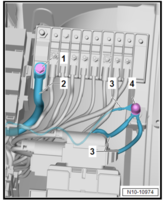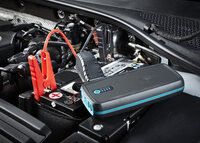You are using an out of date browser. It may not display this or other websites correctly.
You should upgrade or use an alternative browser.
You should upgrade or use an alternative browser.
Battery Charging - Main Battery Chassis Point -
- Thread starter Dellmassive
- Start date
ALL. My 2006 bmw 530d has the same sensor and it's not even got stop/start ( but has an energy management system)Is this for all startstop vehicles or something VW have on the negative terminal ?
Thank you sirALL. My 2006 bmw 530d has the same sensor and it's not even got stop/start ( but has an energy management system)

As it seems to take quite long for CTEK to reintroduce the withdrawn software, just got intrigued and reloaded the older software to see if there was something totally wrong.Actually, in July CTEK slipped out a software which instead of vague SOC chart (as above) showed actual recorded voltage/temperature values (similar to BM2-monitor charts). However, the software was withdrawn in few days.
Interestingly the withdrawn CTEK Battery Sense seems to work just fine on Android 10. However, running the app on Android 6 seems to have random drop-outs in updating but not too bad. I've been running these just a few days so the results are by no means comprehensive.
The withdrawn app in question is version V2.3.4 and has date stamp 2019-07-01.
PS. App auto-update must then be turned off - otherwise this old one will be overwritten in a few hours.
However, scaling of voltage graph doesn't really help - below the change is from 12.60V to 13.22V.
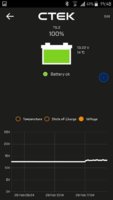
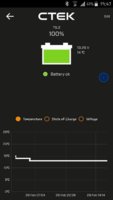
Hi Martyn I don't suppose you still have some of these?The Victron chargers also use those disconnects and I have some spare sets. If you want one it would just be postage to pay.
I didn't forsee Covid19 when I wired my van so there's no Starter battery charging (until my solar goes in, then its via the renogy). So if I can fit a *single pole connector on my charger outlet, and a single pole connector on the renogy IN/OUT I can quickly swap the EHU charging between batteries.
*Or double pole with an unused pin
Could you please post a photo of earth point 12Battery Charging - Main Battery Earth Point -
so weve all be told NOT to bridge out the battery monitor on the neg side of the battery when charging it.
This is so the ECM can correctly gauge the SOC (state of charge) of the starter battery by monitoring the current flow in and out of the battery . . . . even when the van is sleeping.
View attachment 34123
OK fine, no problem there . . . . . so my question to all is where are you picking up your chassis ground point? . . . . and one thats good enough to allow the 15amps charge that my charger is putting out?
View attachment 34125
currently all i found was this small stud under the valence . . . . . but it seems a bit iffy . . . .
View attachment 34124
no i also this question as the manual clearly states that you must use a chassis or engine block ground . . . . . but where is one? nearly everything is plastic and my lead is to short to reach down to the block.
View attachment 34126
now as a comparison, our old BMW has the battery in the boot, it has a nice long chunky cable that runs along the under-body and up into the engine bay, to a nice convenient jump-point under a nice red plastic cover under the bonnet by the suspension turret . . . . . now right next to this point is a large chunky BOLT type thing bolted to the chassis for the purpose of a ground jump cable connection.
so has VW just not done anything about the NEG connection point?. . . . . or am i missing something?
why do you guys do?
EDIT: additional info,
View attachment 36699
.
12 Earth point, on left in engine compartment
q Specified torque: 9 Nm
13 Earth point, on right in engine compartment
q Specified torque: 9 Nm
15 Earth point, on cylinder head
q Specified torque: 9 Nm
607 Earth point, on left in plenum chamber
q Specified torque: 9 Nm
614 Earth point 2, on right in engine compartment
q Specified torque: 20 Nm
624 Earth point, starter battery
q Specified torque: 20 Nm
640 Earth point 2, left in engine compartment
q Specified torque: 9 Nm
642 Earth point for electronically controlled fan
q Specified torque: 9 Nm
714 Earth point on right of engine
q Specified torque: 20 Nm
.
Thanks, I shall look for thatwill this do? Its Item 4.
View attachment 75809
But you are bypassing the main battery monitor if you do this.I hard wired my Ctek quick disconnect negative to the battery clamp. They are only short and that works fine. It's similar without the fuse as per Dell's top photo. I did have to enlarge the hole slightly to get the bolt through.
OK Loz, bring me up to scratch on this. I thought that you shouldn't go directly to the negative battery terminal on modern cars/vans? So should I now connect the neg direct to the battery and what is the battery monitor actually doing?But you are bypassing the main battery monitor if you do this.
When you said ctek quick connect, is that for a charger? As the monitor can go on the terminals but a charger needs to go to chassi.OK Loz, bring me up to scratch on this. I thought that you shouldn't go directly to the negative battery terminal on modern cars/vans? So should I now connect the neg direct to the battery and what is the battery monitor actually doing?
Yes Loz its a Ctek MSX 5.0 charger to keep the starter battery toped up. Not getting a lot of use just now.When you said ctek quick connect, is that for a charger? As the monitor can go on the terminals but a charger needs to go to chassi.
Then chassis negative.Yes Loz its a Ctek MSX 5.0 charger to keep the starter battery toped up. Not getting a lot of use just now.
Thanks.Then chassis negative.

When you said ctek quick connect, is that for a charger? As the monitor can go on the terminals but a charger needs to go to chassi.
@Loz just to confirm in respect of the above, namely battery monitor connections. I just receved the BM2 monitor. Should its earth wire be connected to the negative battery terminal then instead of the chassis bolt to the side of the battery or either would do? Which is better? Many thanks.
Monitor across the battery, everything else to the chassis@Loz just to confirm in respect of the above, namely battery monitor connections. I just receved the BM2 monitor. Should its earth wire be connected to the negative battery terminal then instead of the chassis bolt to the side of the battery or either would do? Which is better? Many thanks.
I have purchased a Ring RPPL400 16800 mAH Lithium Jump Starter as I am having issues with my 2 year old engine battery (a Varta one). I have a BM2 monitor attached over the battery terminals and that regularly shows low voltage (Currently shows approx 11.5v) The main dealer had the van in for a couple of days last October and have tested for parasitic drain etc but couldn't find anything wrong so are refusing to change the battery.
Does anyone have any thoughts on my battery issue.
In addition I am aware from this thread that the negative cable from the battery booster needs connecting to a ground on the van instead of direct to the battery.The front nearside headlight bracket bolt seems to be the nearest point to the battery and is the best option for me as the booster cables are very short. However the crocodile clips of the booster aren't able to grip onto this bolt head. Is there anything I can connect to the bracket bolt, to which I can then connect the booster crocodile clip. For info incase it makes any difference, the battery booster is pretty high power (starting up to 6L petrol & 3.5L diesels)
I have seen reference to using M8 eyelets is this OK? If so are the ones below Ok for my purpose? I assume I would just remove the yellow rubber and connect the crocodile clip to that end. Would that work?
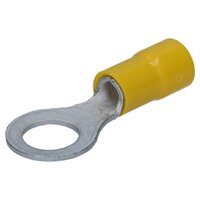
Does anyone have any thoughts on my battery issue.
In addition I am aware from this thread that the negative cable from the battery booster needs connecting to a ground on the van instead of direct to the battery.The front nearside headlight bracket bolt seems to be the nearest point to the battery and is the best option for me as the booster cables are very short. However the crocodile clips of the booster aren't able to grip onto this bolt head. Is there anything I can connect to the bracket bolt, to which I can then connect the booster crocodile clip. For info incase it makes any difference, the battery booster is pretty high power (starting up to 6L petrol & 3.5L diesels)
I have seen reference to using M8 eyelets is this OK? If so are the ones below Ok for my purpose? I assume I would just remove the yellow rubber and connect the crocodile clip to that end. Would that work?

Ok Thanks for that.
However reading AA advice for when jump starting from another car they recommend attaching the negative lead to a ground point as well. Is that different to atatching a jump booster?
A step-by-step guide to jump starting a car
Find someone with a car who’s happy to help. Their car must have a fully charged battery with the same voltage as yours (usually 12 volts).
1. Line up both cars
However reading AA advice for when jump starting from another car they recommend attaching the negative lead to a ground point as well. Is that different to atatching a jump booster?
A step-by-step guide to jump starting a car
Find someone with a car who’s happy to help. Their car must have a fully charged battery with the same voltage as yours (usually 12 volts).
1. Line up both cars
- Park both cars so their batteries are within easy reach of one another (without the cars actually touching).
- Keep the handbrakes on and the ignitions off.
- Use the red jump lead to connect the working battery’s positive (+) terminal to the flat battery’s positive (+) terminal.
- Take the black jump lead and attach it to the negative (-) terminal on the working battery.
- Then attach the other end to an earthing point (unpainted metal on the engine block or chassis) well away from the flat battery and fuel system.
- Keep both engines off and wait for 3 minutes, then start the working car’s engine and let it run for 1 minute.
- Turn on the engine in the car with a flat battery.
- Leave both cars to idle, at a fast pace, for around 10 minutes.
- Turn off both cars’ engines and carefully disconnect the leads in the reverse order to the way they were connected (remove the black lead from your car first and finish with the red lead from the other car).
- Make sure the leads don’t touch one another, or either car, as you remove them.
- Try turning the keys in the ignition to see if your car will start up.
Similar threads
- Replies
- 3
- Views
- 512
- Replies
- 7
- Views
- 1K
- Replies
- 4
- Views
- 321
- Replies
- 46
- Views
- 2K

